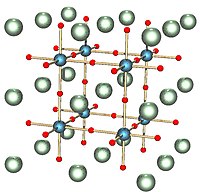
Photo from wikipedia
Compared with traditional organic-inorganic hybrid perovskites, CsPbI3 is considered to be a better solar photovoltaic absorption material. However, under environmental conditions, it will undergo the phase transition from the α… Click to show full abstract
Compared with traditional organic-inorganic hybrid perovskites, CsPbI3 is considered to be a better solar photovoltaic absorption material. However, under environmental conditions, it will undergo the phase transition from the α phase to the γ phase and finally to the non-perovskite phase (δ), especially in a humid environment. Considering the important role of surface intrinsic defects in the phase transition process, we investigated the intrinsic defects on α, γ and δ-CsPbI3 (001) surfaces by first-principles calculations based on density functional theory (DFT). The formation energy of most defects on the surface is similar to that in the bulk in all three phases except for VPb and VI. The formation energy of VPb and VI on the α-CsPbI3 (001) surface is significantly increased, and the formation energy of VPb on the γ-CsPbI3 (001) surface is also increased, due to the relaxation and distortion of the surface Cs and the Pb-I octahedron. The formation energy of interstitial defects on the α-CsPbI3 (001) surface is the lowest due to the remaining large dodecahedral void, even though the Pb-I octahedron distortion has largely enhanced the stability of the α-CsPbI3 (001) surface. The formation energy of VCs is the lowest in all three phases, indicating that Cs ions in CsPbI3 are indeed flexible in CsPbI3. The results are expected to provide a theoretical basis and guidance for the stability improvement of all-inorganic halide perovskites especially in a humid environment.
Journal Title: Physical Chemistry Chemical Physics
Year Published: 2023
Link to full text (if available)
Share on Social Media: Sign Up to like & get
recommendations!